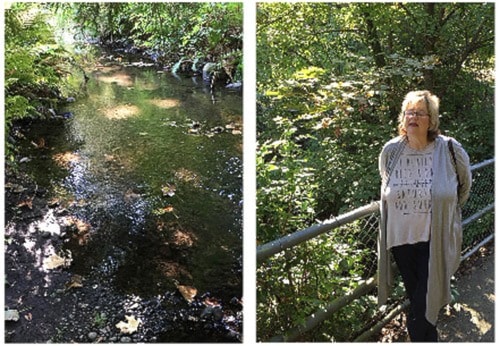The revised Section 35 (habitat protection) of the Fisheries Act will come to haunt us in the next decade
– Otto Langer, retired DFO officer, 2012.
Without consulting local stream keepers and other key stakeholders, the Department of Fisheries and Oceans recently approved alteration of a productive salmon stream in Port Coquitlam.
The plan – to fill in the existing channel of Maple Creek for 55 metres and move it five metres north – now hinges on an upcoming vote on Port Coquitlam council.
Here’s how the story’s gone so far.
Yang de Yang, a retired businessman from China, wants to replace his house at 2545 Kitchener Avenue in Woodland Acres with a 10,000 sq. ft. one and 3,000 ft. garage.
It would be a ‘dream home’ for his daughter and her extended family.
Brad Fanos, a DFO manager based in Vancouver, approved the alteration plan.
“The Fisheries Protection Program,” he explains, “follows current program legislation, regulations, policies and operational procedures when conducting all regulatory reviews, including this proposed project.”
Sandy Budd, Maple Creek Stream Keepers President, can’t understand why nobody at DFO consulted her about the alteration plan.
“I found out about it from the neighbors,” she says.
“That’s a head-scratcher,” says PoCo Coun. Brad West. “No group of people has more knowledge about how to protect the creek than the MCSK. You’d think they would be the first people DFO talked to.”
Right.
“When you move a stream, you disturb the nutrients in the soil,” warns Budd. “You’ll never get back its total productivity.”
Budd’s 35-member group has nurtured Maple Creek for 20 years. It’s a beauty.
A lush canopy of trees provides shade in summer for growing fish. Clean, oxygenated water bubbles over rocks. Dark pools provide refuge from predators.
Budd says the creek supports thousands of coho fry, crayfish, endangered cutthroat trout.
Recently, the stream keepers trucked in spawning gravel. The group hosts a local school’s “Salmonids in the Classroom Program.”
Every June, says Budd, local school kids release fry into the creek at River’s Day ceremonies last month.
Another key stakeholder is DFO’s man on the ground for the north Fraser area, community advisor Maurice Coulter-Boisvert. He supports streamkeeper work and promotes salmonid awareness.
“My employer didn’t ask me for my input,” Coulter-Boisvert said when I asked what role he played.
Then, there’s Port Coquitlam.
“DFO managed this issue without consulting the city,” says West. “We found out about it on our own. It’s a case study of what shouldn’t happen. Luckily, our city policies [permits issued for work around water bodies] stopped it. Otherwise, the owner would have been off to the races.”
It’s a script all municipalities should anticipate for their streams – the strength of local bylaws protecting fish and habitat, not DFO policy or in-house biologists they don’t have any more.
Will the application to dig up Maple Creek go forward?
“Maybe,” says West, who vows to oppose it. “Let’s say this gets denied. That doesn’t mean every application [like this] will be. That’s why the involvement of citizens is important.”
Not all councilors are fish-friendly.
Tough legislation and supportive DFO policies must be back in place to block water body alterations that affect wild salmon and habitat. Current ones don’t.
In 2012, I wrote that Otto Langer predicted the Stephen Harper government would end protection for most wild fish and streams; supplant wording like “no alteration or disruption of fish habitat” with ones that only guard “fish of economic ... value.”
Catastrophic cuts to DFOs budget and officers on the ground since have made monitoring and enforcement by DFO a thing of the past.
In 2012, Justice Bruce Cohen termed Harper’s Bill C-38, “troubling.” He added, “Many experts have emphasized the importance of protecting fish habitat ... and promoting eco-system practices.”
But amendments to the Fish Act appear to be taking the DFO “in a different direction.”
For me, the testimony of John Davis, a former deputy minister of fisheries, underscored what must happen to turn the DFO back.
“We need a lot more talk about who makes decisions we all have to live with,” he said, referring to economic costs versus ecological biodiversity.
As an example, he gave DFO management’s decision to abandon the habitat of a unique species of Cultus Lake sockeye.
Want to alter a stream today? The DFO website gives do-it-yourself proponents steps for assessing work and its impact on fish. You might hire an environmental consultant, it says.
Mr. Yang did.
And, “if you still have questions,” you can call the DFO for help.
Current law and new policies make Maple Creek and 99 % of Canada’s streams vulnerable. They erase protection most fish and habitat once had. They must be reversed by Trudeau. He promised they would be.
“That seems to be the missing part of the system,” says West. “If the appropriate federal legislation isn’t in place – that’s the problem.”
Jack Emberly is a retired teacher, local author and environmentalist.
